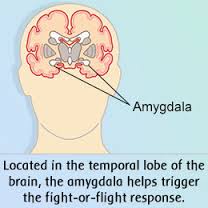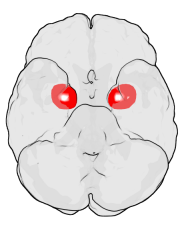A Dab of Science
Emotional memories can cause us to feel fear, anger and stress in situations where those emotions are not adaptive or helpful.
The amygdala, a part of the brain that plays a key role in emotional memory, can trigger stress, fear or an aggressive response faster than we can think. Based on past information and situations, it can keep us trapped in negative emotional patterns that can lead to health challenges and counterproductive behavior.
The Connection Practice not only calms the reactions of the amygdala, but it activates our highest and best intelligence.
The amygdala is, of course, not the only aspect of the body-mind that can trigger emotions and behaviors. In fact, there is a constant and complex web of interactions going on within each of us all the time, and any change anywhere in this web can change everything. Or, to put it more scientifically, ". . . healthy, optimal function is a result of continuous, dynamic, bi-directional interactions among multiple neural, hormonal, and mechanical control systems at both local and central levels." [Heart Rate Variability: New Perspectives on Physiological Mechanisms, Assessment of Self-regulatory Capacity, and Health risk, by Rollin McCraty, PhD, corresponding author and Fred Shaffer, PhD, BCB]
A deliberate smile or closing your eyes can trigger a more relaxed state. A smell, your breathing, physical posture, a thought, or an image can cause a variety of physical, emotional and mental changes. That is why, especially in the early stages of learning, the most effective self-regulatory techniques may combine several of these elements in a way that reinforces the desired effect. For example, the Quick Coherence technique (originally developed by the HeartMath Institute) that is a key part of the Connection Practice typically combines posture (sitting comfortably); closing the eyes; breathing in a slow, relaxed fashion; directing the attention to the "heart" (the center of the chest); and feeling appreciation (for something you previously determined is easy for you to appreciate).

Also see, "Why the 'Empathy' section of the 'Science' page at connectionpractice.org is unconvincing to me"
Studies
For information on studies connected with HeartMath techniques, see HeartMath Institute Science page.
There are a number of scientific studies focusing on Nonviolent Communication, and perhaps more focusing on meditation or mindfulness. The Connection Practice, however, evolved out of both the essence of NVC and a particular form of meditation, namely Quick Coherence from HeartMath. It would appear that very few attempts have been made to scientifically assess the results of combining techniques from NVC with meditation or mindfulness.
One really cool story from our neck of the woods (Washington State) concerns the Freedom Project, a program that teaches NVC and mindfulness practices to prisoners. A study showed that prisoners who went through the training had a significantly lower rate of reoffending (approximately 21% vs. 37%), lower levels of anger, and more ability to express themselves in a non-confrontational way. The study notes, “Extrapolating, if 37% of returnees are expected to reoffend, but only 21% of Freedom Project trainees did so, and if the cost of keeping a man in prison is U.S. $98 per day, training by Freedom Project has saved the state of Washington US$5,065,320.00 per year.” We find this study particularly interesting because, like The Connection Practice, the Freedom Project demonstrates the synergy of NVC and a secular meditation technique (mindfulness).

